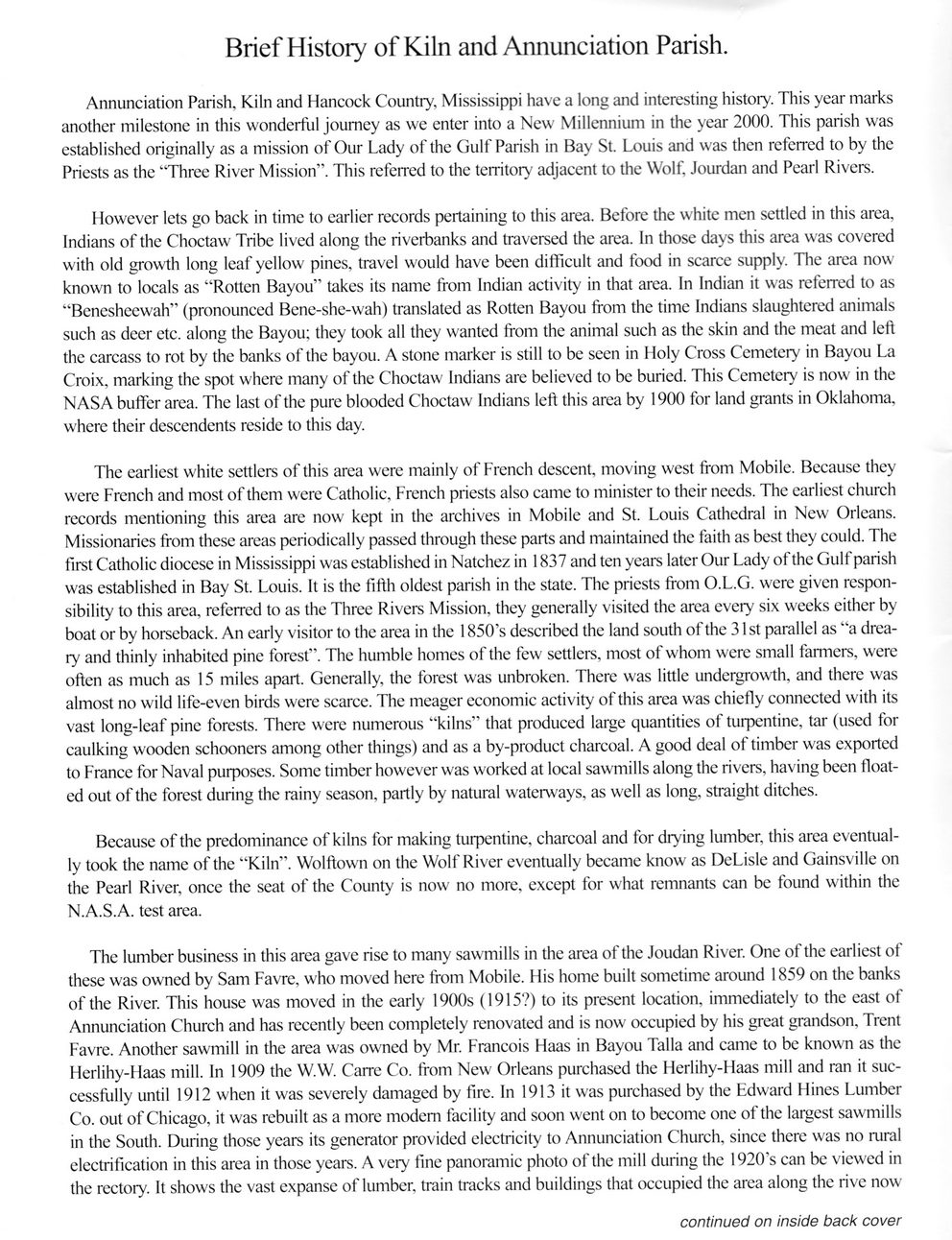This text was obtained via automated optical character recognition.
It has not been edited and may therefore contain several errors.
Brief History of Kiln and Annunciation Parish. Annunciation Parish, Kiln and Hancock Country, Mississippi have a long and interesting history. This year marks another milestone in this wonderful journey as we enter into a New Millennium in the year 2000. This parish was established originally as a mission of Our Lady of the Gulf Parish in Bay St. Louis and was then referred to by the Priests as the ?Three River Mission?. This referred to the territory adjacent to the Wolf, Jourdan and Pearl Rivers. However lets go back in time to earlier records pertaining to this area. Before the white men settled in this area, Indians of the Choctaw Tribe lived along the riverbanks and traversed the area. In those days this area was covered with old growth long leaf yellow pines, travel would have been difficult and food in scarce supply. The area now known to locals as ?Rotten Bayou? takes its name from Indian activity in that area. In Indian it was referred to as ?Benesheewah? (pronounced Bene-she-wah) translated as Rotten Bayou from the time Indians slaughtered animals such as deer etc. along the Bayou; they took all they wanted from the animal such as the skin and the meat and left the carcass to rot by the banks of the bayou. A stone marker is still to be seen in Holy Cross Cemetery in Bayou La Croix, marking the spot where many of the Choctaw Indians are believed to be buried. This Cemetery is now in the NASA buffer area. The last of the pure blooded Choctaw Indians left this area by 1900 for land grants in Oklahoma, where their descendents reside to this day. The earliest white settlers of this area were mainly of French descent, moving west from Mobile. Because they were French and most of them were Catholic, French priests also came to minister to their needs. The earliest church records mentioning this area are now kept in the archives in Mobile and St. Louis Cathedral in New Orleans. Missionaries from these areas periodically passed through these parts and maintained the faith as best they could. The first Catholic diocese in Mississippi was established in Natchez in 1837 and ten years later Our Lady of the Gulf parish was established in Bay St. Louis. It is the fifth oldest parish in the state. The priests from O.L.G. were given responsibility to this area, referred to as the Three Rivers Mission, they generally visited the area every six weeks either by boat or by horseback. An early visitor to the area in the 1850?s described the land south of the 31 st parallel as ?a dreary and thinly inhabited pine forest?. The humble homes of the few settlers, most of whom were small fanners, were often as much as 15 miles apart. Generally, the forest was unbroken. There was little undergrowth, and there was almost no wild life-even birds were scarce. The meager economic activity of this area was chiefly connected with its vast long-leaf pine forests. There were numerous ?kilns? that produced large quantities of turpentine, tar (used for caulking wooden schooners among other things) and as a by-product charcoal. A good deal of timber was exported to France for Naval purposes. Some timber however was worked at local sawmills along the rivers, having been floated out of the forest during the rainy season, partly by natural waterways, as well as long, straight ditches. Because of the predominance of kilns for making turpentine, charcoal and for drying lumber, this area eventually took the name of the ?Kiln?. Wolftown on the Wolf River eventually became know as DeLisle and Gainsville on the Pearl River, once the seat of the County is now no more, except for what remnants can be found within the N.A.S.A. test area. The lumber business in this area gave rise to many sawmills in the area of the Joudan River. One of the earliest of these was owned by Sam Favre, who moved here from Mobile. His home built sometime around 1859 on the banks of the River. This house was moved in the early 1900s (1915?) to its present location, immediately to the east of Annunciation Church and has recently been completely renovated and is now occupied by his great grandson, Trent Favre. Another sawmill in the area was owned by Mr. Francois Haas in Bayou Talla and came to be known as the Herlihy-Haas mill. In 1909 the W.W. Carre Co. from New Orleans purchased the Herlihy-Haas mill and ran it successfully until 1912 when it was severely damaged by fire. In 1913 it was purchased by the Edward Hines Lumber Co. out of Chicago, it was rebuilt as a more modem facility and soon went on to become one of the largest sawmills in the South. During those years its generator provided electricity to Annunciation Church, since there was no rural electrification in this area in those years. A very fine panoramic photo of the mill during the 1920?s can be viewed in the rectory. It shows the vast expanse of lumber, train tracks and buildings that occupied the area along the rive now continued on inside back cover

Annunciation Church Kiln 1